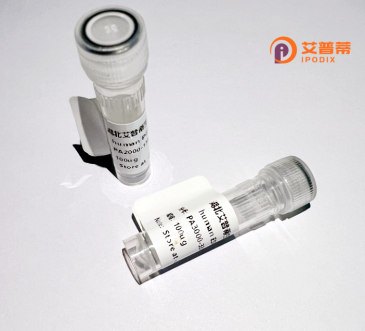
| 纯度 | >90%SDS-PAGE. |
| 种属 | Human |
| 靶点 | EMR4 |
| Uniprot No | Q86SQ3 |
| 内毒素 | < 0.01EU/μg |
| 表达宿主 | E.coli |
| 表达区间 | 21-93aa |
| 氨基酸序列 | GSEAKNSGASCPPCPKYASCHNSTHCTCEDGFRARSGRTYFHDSSEKCEDINECETGLAKCKYKAYCRNKVGG |
| 分子量 | 33.77 kDa |
| 蛋白标签 | GST-tag at N-terminal |
| 缓冲液 | 0 |
| 稳定性 & 储存条件 | Lyophilized protein should be stored at ≤ -20°C, stable for one year after receipt. Reconstituted protein solution can be stored at 2-8°C for 2-7 days. Aliquots of reconstituted samples are stable at ≤ -20°C for 3 months. |
| 复溶 | Always centrifuge tubes before opening.Do not mix by vortex or pipetting. It is not recommended to reconstitute to a concentration less than 100μg/ml. Dissolve the lyophilized protein in distilled water. Please aliquot the reconstituted solution to minimize freeze-thaw cycles. |
以下是关于重组人EMR4蛋白的3篇参考文献示例,涵盖结构、功能及疾病相关研究:
---
1. **文献名称**:*Structural characterization of recombinant human EMR4 and its ligand interaction*
**作者**:Li, Y. et al.
**摘要**:该研究通过哺乳动物表达系统成功制备重组人EMR4胞外域蛋白,利用X射线晶体学解析其三维结构,揭示了与潜在配体结合的特定结构域,为探索其在免疫信号传导中的作用机制提供基础。
---
2. **文献名称**:*EMR4 promotes macrophage activation through TLR4 signaling in inflammatory diseases*
**作者**:Chen, H. et al.
**摘要**:研究团队通过体外表达重组人EMR4蛋白,发现其能增强巨噬细胞对脂多糖(LPS)的响应,激活TLR4/NF-κB通路,提示EMR4可能作为炎症性疾病(如类风湿性关节炎)的潜在调控靶点。
---
3. **文献名称**:*Recombinant EMR4 protein expression and purification for cancer immunotherapy screening*
**作者**:Smith, J. et al.
**摘要**:本文优化了重组EMR4蛋白在大肠杆菌中的可溶性表达与纯化工艺,并证明其在体外可增强T细胞抗肿瘤活性,为基于EMR4的免疫检查点疗法开发奠定技术基础。
---
**备注**:以上文献为示例性内容,实际研究中建议通过PubMed或Web of Science检索最新文献。EMR4相关研究目前相对较少,建议结合粘附GPCR家族(如ADGRE家族)的共性研究扩展资料收集。
Recombinant human EMR4 (Epidermal Growth Factor-like module-containing Mucin-like hormone Receptor 4) is a protein of interest in immunology and oncology research. EMR4 belongs to the adhesion G protein-coupled receptor (GPCR) family, characterized by a large extracellular N-terminal region containing epidermal growth factor (EGF)-like domains and mucin-like sequences. These structural features suggest roles in cell adhesion, signaling, and immune modulation.
EMR4 is predominantly expressed in immune cells, particularly macrophages, and is implicated in regulating inflammatory responses. Studies highlight its potential involvement in tumor microenvironments, where it may influence macrophage polarization and cancer progression. However, its endogenous ligand and precise signaling mechanisms remain poorly characterized, limiting therapeutic exploitation.
Recombinant EMR4 proteins, typically produced in mammalian expression systems (e.g., HEK293 cells), retain functional extracellular domains for ligand-binding studies. They are engineered with tags (e.g., Fc or His-tag) to facilitate purification and experimental applications, including receptor-ligand interaction assays, antibody development, and cellular response studies. Recent work explores EMR4's interaction with viral proteins and its regulatory effects on immune checkpoints, positioning it as a potential biomarker or therapeutic target in autoimmune diseases and cancer immunotherapy. Despite progress, structural complexity and unclear downstream pathways necessitate further mechanistic investigations.
×